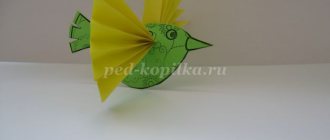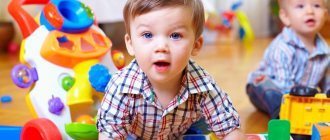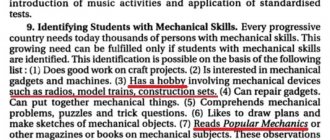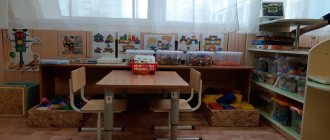Construction in an early age group
| Spring. Transformations, revitalization, awakening of nature. | |||||||||||||||
| 17 | 14.05 | Spring | Sand construction | Reinforce knowledge about the properties of sand. Learn to build a tower, a dog house, paths, benches, tables, etc. Develop thinking, memory, and creativity. Cultivate an interest in sand construction. | Sandbox | Cognitive development (formation of a holistic picture of the world, expansion of horizons, development of research activities, femp), speech development, hair (literary art), skr (s\r\i), physical | I.A.Lykova Design in kindergarten p.18 | ||||||||
| 18 | 28.05 | Flowers | Fences high and low | Teach: change the building in height; name the details: bricks, cubes; build a variety of fences, different in height. Strengthen the ability to arrange parts. Develop a sense of shape and color, an interest in flowers. To cultivate the ability to see the beauty of nature, understand its fragility, and evoke a desire to protect it. | Construction sets, decorative flowers on stands | Cognitive development (formation of a holistic picture of the world, broadening one’s horizons, development of cognitive and research activities, femp), hair (literary arts), physical development | I.A.Lykova Construction in kindergarten p.17 | ||||||||
Pedagogical monitoring is carried out in order to determine the dynamics of the child’s current individual development profile and is used to solve the following problems: • individualization of education (including supporting the child, building his educational trajectory or professional correction of his developmental characteristics); • optimization of work with a group of children. Pedagogical monitoring is based on the principles of supporting the specificity and diversity of childhood, as well as the uniqueness and intrinsic value of childhood as an important stage in the overall development of a person. In this regard, pedagogical monitoring: - does not contain any assessments of the child’s development related to recording educational achievements; — allows you to record the current individual development profile of a preschooler and evaluate its dynamics; — takes into account the child’s zone of proximal development in each direction; — allows us to consider the entire period of a child’s development from birth to school as a single process without conditional division into different age stages “tied” to the passport age, while taking into account age-related patterns of development, based on an assessment of changes in the activity of a preschooler; — takes into account the targets presented in the Program, but does not use them as the basis for their formal comparison with the actual achievements of children. Tools for pedagogical monitoring of child development - observation cards and an electronic application that will allow teachers to analyze the dynamics of child development. Where calculations are carried out using a certain formula. The results obtained are expressed as percentages and determine the so-called success rate of each child. At the beginning of the school year, based on the results of monitoring, the zone of educational needs of each student is determined: a high level corresponds to a zone of increased educational needs, a medium level corresponds to a zone of basic educational needs, and a low and low level corresponds to a risk zone. Accordingly, planning of the educational process is carried out based on the integration of educational areas, taking into account individualization. At the end of the school year, conclusions are drawn about the degree to which the educational needs of children are met and about the achievement of positive dynamics in the educational needs themselves. Principles of assessment - three-level monitoring system - 2 points “quality manifests itself sustainably”, 1 point “quality manifests itself unsustainably”, i.e. is in the zone of proximal development and is manifested only in joint activities with an adult, 0 point - “quality is not manifested.” In some cases (if necessary), psychological diagnostics of children can be carried out. It is carried out by qualified specialists (for example, educational psychologists) and only with the consent of the parents (legal representatives) of the children. The information obtained during monitoring is the basis for predicting activity, making the necessary correction, and a tool for notifying parents about the condition and problems identified in the child. Diagnostic card: Type of activity: Construction
MAGAZINE Preschooler.RF
Consultation for parents “Designing children at an early age”Constructive activity is a practical activity aimed at obtaining a specific, pre-conceived real product that corresponds to its functional purpose. Construction has extremely wide possibilities for mental, moral, aesthetic and labor education.
Construction for young children involves the construction of various buildings from building materials. During the construction process, children's sensory and thinking abilities are developed. Construction meets the interests of children, satisfies their cognitive activity, develops imagination, ingenuity, and contributes to the active formation of technical thinking.
Children's construction can be considered as a means of developing children's abilities. Playing with building materials has an impact on the all-round development of the child. Children's construction is closely related to play: children's buildings are used for practical use and for play. Role-playing game is the motive for creating buildings; the initiator of children’s games is an adult. “side by side” develop during the learning process .
A variety of building materials develops children's creative activity. You should think about the selection and variety of building materials.
By placing it accessible, so that it is convenient for kids to play with it. “Builder” set (cube, “brick” , triangular prism, plate, cylinder), large geometric mosaics, and “Lego” .
To play with buildings, you need toys commensurate with the ones being created.
buildings (cars, dogs, cats, nesting dolls, etc.).
The construction of a building requires concentration, attention, and memory from the child. The movements of children’s hands also develop, they become precise, dexterous, and purposeful. This means that children’s games with building materials contribute to the development of fine motor skills.
Children learn to correctly name the parts of a building material (cube, brick, prism, plate). Understand and correctly use words (big - small, long - short, high - low, wide - narrow). According to the verbal instructions of an adult, the child learns to perform certain actions: apply, attach, attach, remove, put, remove, disassemble.
The main goal of teaching design is to develop the child’s thinking, his moral qualities, aesthetic feelings, and not just to teach how to perform this or that craft.
The basis for teaching children to design is organized activity in which various methods and techniques are used: showing and analyzing a sample, explaining the sequence and methods of constructing, creating problem situations that require finding an independent solution.
When working with children, it is necessary to use artistic expression and play techniques that help to interest children in this type of activity. You definitely need to learn how to beat the created buildings
after all, this helps to increase children’s interest in designing and
will help them incorporate the acquired skills into independent activities and games.
Recommendations for introducing children to construction sets
- Having placed a set of construction games in front of your child, take the construction set pieces one at a time. Invite your child to touch the part, examine it, and name it.
- In order for the child to learn the name of the parts of the set, use “objectification” - any geometric figure of a building material is similar to some known object (prism - roof, brick - board, cube - car cabin, - cylinder column).
- It is most convenient to play on the floor. You will not be afraid that the building will fall or there will not be enough space to build.
First you need to introduce your child to buildings made from identical geometric shapes: cubes or bricks.
- Towers made of cubes (made of cubes)
- Narrow and wide paths (made of bricks)
- Fence (made of bricks)
- Gate (made of bricks)
- Airplane (put two bricks crosswise)
- Train (made of bricks).
We use and play with the building with toys.
For example: “Let’s put the cat and dog in the trailers .
- Ladder (made of cubes)
The next stage of design, when you can move on to combining two or three familiar construction set parts (cube and brick, cube and prism, cylinder, cube and brick)
- Machine (cube and brick)
- House with a roof (cube and prism)
- Slide (cube and prism)
- Chair and table (cube and brick)
- Bridge, bench (cube and brick)
- Steam locomotive (brick, cube, cylinder)
By age 2, children can build simple structures from one or two different parts. By the age of 3, structures become more interesting and complex. Children can build structures from 3 and 4 different parts:
“Furniture for a doll” (table, chair, sofa); “Tower with a fence and a gate for a cockerel” ; "Road and Bridge" . There is no need to rush if the child has not yet learned the principles of building structures from 2 or 3 different parts. It is important to encourage your child to play with construction sets, show interest and sympathy for his failures, and be patient even with strange ideas!
| Next > |
SECTION 6. DESIGN FOR CHILDREN FROM 2 TO 3 YEARS OLD
INTRODUCTION TO CONSTRUCTION PARTS AND THEIR NAMES, COLOR, SHAPE, SIZE
By the age of 2, the child’s frontal parts of the cerebral cortex are intensively developing. That is why children at this age can already play more focused, are less distracted, act more purposefully, and better distinguish the shape, size and color of objects.
A child can choose from a box of construction set parts only columns or only cubes, i.e. the parts are of the same shape, but they will be cubes of different sizes and colors.
The child can easily navigate the details of the construction set and knows their names well, does not confuse them (if he was introduced to their names before, in the second year of the baby’s life).
If you work with a child, then by the age of 2.5 years the child understands the request “Give me the same color” and clearly distinguishes yellow, red, blue and green colors. And by the age of 3, he can also distinguish some other colors - orange, purple, blue and can correctly name all seven colors of the rainbow. And also distinguishes shades of colors: “Where is the dark green cube? Where's the light green one? The child also distinguishes achromatic colors: white, gray, black.
By the age of 3, a child can already name 2-3 characteristics of a construction set: “Yellow big cube” or “small brick”.
In the third year of life, you can introduce a new task - start using colored cubes to lay out multi-colored patterns from them (like a mosaic) and multi-colored paths with alternating colors (for example, yellow and red bricks alternate in a path to make a pattern).
PLAYING WITH THE CONSTRUCTOR
To play with a 2-year-old child, we do not take the entire set of construction set parts, but 10-12 pieces of parts of different shapes and sizes that are already familiar to the child.
To the designer set, be sure to add a box with small toys commensurate with the details of the designer. These are toys with which your baby will play with the building together with you. For example, he will be able to place a toy cockerel on a newly built fence, saving it from a fox. Or your child will help a toy cat climb a ladder made of bricks. Or he will place the bunny in a house built for him. These can be small figurines of fairy-tale characters, animals, nesting dolls, and family figurines.
In this box we will also put natural materials: cones, acorns, sticks, which the child may need when playing with the construction set and which can become substitute objects. For example, you can make a man out of a pine cone, and use the caps of acorns as bowls for food to play out the plots.
You can print pictures of fairy tale characters on cardboard, put them on stands and use them to act out stories. Or use figurines commensurate with the details of the designer for a tabletop theater.
A two-year-old child cannot build for the sake of learning something; he definitely needs a game plot. He must see the toy for which he is building and understand why this toy needed his construction.
For example, mom plays out a scene. A little matryoshka comes to visit a child, it’s her housewarming party and you need to help her arrange her room. Matryoshka really needs a table and a chair, because she loves to drink tea with her girlfriends. Mom and child build a table from cubes, and then chairs (a brick is placed behind the cube so that it stands vertically like the back of a chair). The buildings are ready! And the main thing for the child began - playing with them. Matryoshka receives guests, seats them at the table, treats them, everyone drinks tea from toy cups. The guests play or dance with the child and the performance of the scene ends there.
You can further vary this scene in different ways. For example, the nesting dolls were tired and decided to lie down. But there are no beds! Let's build them. We build our own bed for each nesting doll.
Another option is also possible: after drinking tea, the nesting dolls decided to go for a walk, and then we, together with the child, will build a park for them, make a long walking path in it and make benches from bricks placed on cubes.
Or maybe next time we will build not a table and chairs, but a long sofa, on which our nesting doll girlfriends will sit and talk with each other.
If a child makes a mistake, it is also corrected in a playful way. For example, a child built a gate, but it turned out to be too narrow for a toy car to pass through. What should I do? Toy - the driver of the toy car tells the child that he cannot drive through the gate built by the child. The gate was too narrow! How to fix it? The kid must figure out how to make the gate wider. The car will pass through them, and the driver will definitely thank him for his help. If the child is upset because of failure and cannot find a solution to the problem, then an adult helps him and suggests a way out of the situation, completes the building together with the child to ensure the child’s success. The car drives through the gate, and the baby is happy.
SECTION 4. HOW CHILDREN FROM 1 YEAR TO 1 YEAR 6 MONTHS PLAY WITH CONSTRUCTION TOYS
FEATURES OF GAMES WITH CONSTRUCTORS AT THIS AGE
Why do children from 1 year to 1 year 6 months often break toys? Why do they build and then destroy buildings, separate and reconnect parts of the construction set, put them in and take them out of the box again and are ready to repeat this endlessly?
At this age, any child is an explorer of the world. He learns the physical properties of the objects that surround him. This is why children at this age love to assemble and disassemble toys. It is in such seemingly meaningless games that there is a very deep meaning for the development of a child. They develop the baby’s sensorimotor intelligence, visual and effective thinking, and the ability to establish internal connections between objects. This is not pranks, not a lack of attentiveness, but this is an experience that a little man really needs - a serious acquaintance with the world around him. Give him the opportunity to do this! Give the opportunity to build a tower and destroy it, build it again and destroy it again - this is the process of learning about the world for the baby. Breaking a tower is the first stage of playing with a construction set, which all children go through and which cannot be avoided :).
INTRODUCTION TO CONSTRUCTION DETAILS, COLOR, SHAPE, SIZE
Already before the age of one and a half years, we begin to correctly name the parts of the construction set to the child. As a result, the baby can distinguish a cube from a ball or a cube from a brick. He can give the same item to an adult (“Give me the same!”), finding the item among 3-4 options.
For example:
- The baby can give his mother a yellow brick (the mother holds a brick in her hands and asks to find the same one), selecting it from bricks of three different colors.
- The child can give his mother a large cube (the same one his mother is holding in her hands), selecting it from three other different parts of the construction set. It distinguishes big cubes from small ones.
PLAYING WITH THE CONSTRUCTOR
The baby cannot yet build from a construction set himself, but uses construction blocks in games with his mother - for example, transporting them in the back of a toy car. Or she puts the doll to sleep on the crib that her mother built for her from builder’s parts.
Also, the baby can use the parts of the construction set as substitute objects in games. For example, instead of soap, he can wash a doll with a brick from a construction set if his mother teaches him to use substitute objects in the game. And a narrow long column - a “stick” - can serve as anything in the game depending on its length - from a thermometer that we put on a bear to a spoon or a comb for combing a doll’s hair.
A mother can show her child how to build the simplest buildings - a tower from identical cubes or a train from cubes (each cube is one train carriage, chug-chug - chug, the train is moving!), paths from bricks, or a table (we put it on top of the cube brick).





